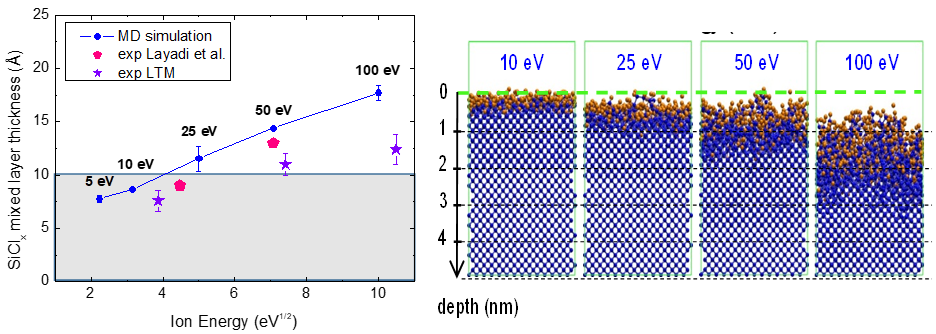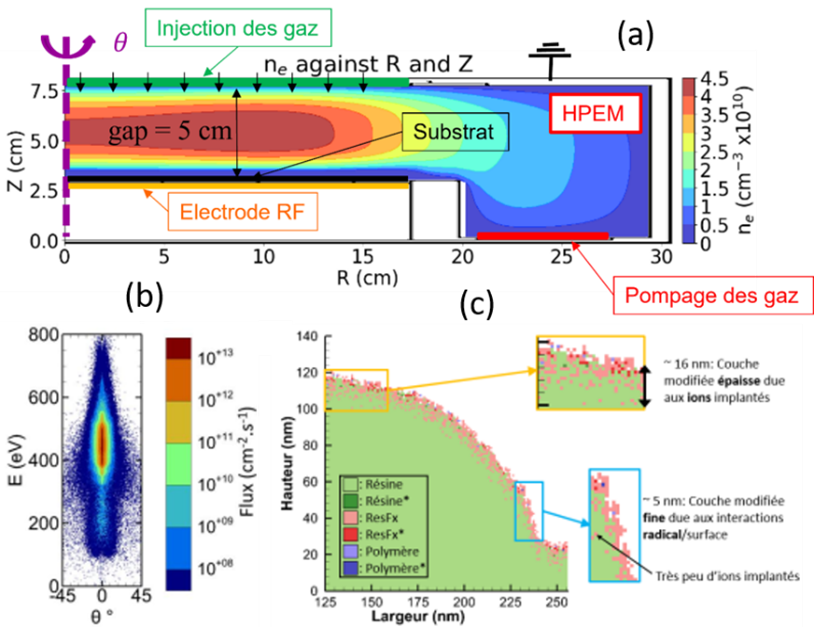- Share
- Share on Facebook
- Share on X
- Share on LinkedIn
a) Molecular dynamics simulation of plasma-surface interaction
The development of plasma processes for surface treatment (etching, deposition, surface activation, etc.) requires a fundamental understanding of the reaction mechanisms involved in plasma-material interaction. Combined with in-situ diagnostics of plasma and surfaces, atomistic simulations such as Molecular Dynamics (MD) can provide information on the processes involved at the atomic scale, and help to understand the chemico-physical mechanisms governing these interaction in low-pressure plasmas. MD simulations developed at LTM have 2 objectives : to better understand the role of ion energy in plasma-material interaction, and to determine how plasma species (ions, reactive radicals) induce structural and chemical changes (defects, segregation, voids) in exposed ultrathin films. Since 2011, MD has proven to be a powerful tool to support experimental research and assist process development within the PROPSECT team. Our work focuses on the fundamental understanding of advanced plasma technologies (pulsed or low electron-temperature plasmas, ALE processes, cryogenic plasmas) for the transfer of nanometric patterns onto thin-film materials (silicon, silicon nitride, silicon oxide, etc.) or 2D materials (e.g. graphene). Covering a wide range of topics, MD allows to investigate elementary surface reactions [1], validate the feasibility of theoretical concepts [2], identify and explain underlying mechanisms involved in etching processes [3,4], or predict plasma parameter ranges for optimizing these processes [5].

Figure 1 : MD simulation of chlorine plasmas interaction with silicon. (left) SiClx mixed layer thickness at steady state vs. ion energy for a Cl/Cl+ bombardment with ΓCl/ΓCl+=100. (right) Snapshots of the surface after a Cl+ fluence of 3.5x1015 ions/cm2 for various bombarding ion energies [5].
[1] E Despiau-Pujo, A Davydova, G Cunge et al, Elementary processes of H2 plasma-graphene interaction: A combined MD and DFT study, J. Appl. Phys. 113, 114302 (2013), 10.1063/1.4794375
[2] O Joubert, G Cunge, E Despiau-Pujo, E Pargon, N Posseme, Atomic precision etching by dynamic control of the reactive layer thickness in reactive plasmas, Patent n° 20150228495 (2015)
[3] A Davydova, E Despiau-Pujo, G Cunge, DB Graves, Etching mechanisms of graphene nanoribbons in downstream H2 plasmas: Insights from MD simulations, J. Phys. D: Appl. Phys. 48, 195202 (2015), 10.1088/0022-3727/48/19/195202
[4] V Martirosyan, O Joubert, E Despiau-Pujo, Modification mechanisms of silicon thin films in low temperature hydrogen plasmas, J. Phys. D: Appl. Phys. 52, 055504 (2019), 10.1088/1361-6463/aaefe0
[5] P Brichon, E Despiau-Pujo, O Mourey, O Joubert, Key plasma parameters for nanometric precision etching of Si films in chlorine discharges, J. Appl. Phys. 118, 053303 (2015), 10.1063/1.4928294
b) Multiscale fluid-hybrid modeling of low-pressure reactive plasmas for etching
Other modeling/simulation approaches (e.g. 0D and 2D gas-phase models) are developped to study the transport and dynamics of neutral and charged species in low-pressure reactive plasmas. The temporal evolution and dependence of plasma parameters (temperature and electron density, ionic and radical composition, energy and flux of ions accelerated towards surfaces) are studied as a function of operating parameters (gas composition, RF power, pressure, etc.) and compared with experimental data obtained in the laboratory whenever possible [6]. More recently, our work has focused on the 2D or 3D fluid-hybrid simulation of low-pressure reactive plasma etching processes. This work aims to develop multiscale models (from gas-phase plasma at reactor scale, to etching reactions at substrate scale) based on a hybrid simulation code (HPEM, for Hybrid Plasma Equipment Model) built around 3 modules [7]. The plasma module (fluid-kinetic code) simulates the transport and kinetics of plasma species (densities, velocities, temperatures) in the gas phase, as well as the electric field in the reactor. This information is coupled to a surface chemistry module (Monte-Carlo code) which calculates the flux, energy and angle (EADF) of reactive species impacting the substrate. These data are then used by an etching module (phenomenological Monte-Carlo code) to simulate the evolution of etching profiles over time.

Figure 2 : Multiscale hybrid modelling of carbon resist microlenses etching in DF-CCP CF4 plasmas. a) Electron density in the plasma gas phase, b) IEDAF at the wafer level, c) Etch profile and composition of a microlens after exposure to the plasma [7].
[6] E Despiau-Pujo, M Brihoum, P Bodart, M Darnon, G Cunge, Pulsed Cl2/Ar inductively coupled plasmas processing: 0D model vs. experiments, J. Phys. D: Appl. Phys. 47, 455201 (2014), 10.1088/0022-3727/47/45/455201
[7] P. Ducluzaux, D. Ristoiu, G. Cunge, E. Despiau-Pujo, Impact of plasma operating conditions on the ion energy and angular distributions in dual-frequency capacitively coupled plasma reactors using CF4 chemistry, J. Vac. Sci. Technol. A 42, 013002 (2024), 10.1116/6.0003291
- Share
- Share on Facebook
- Share on X
- Share on LinkedIn